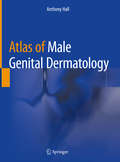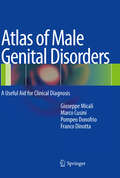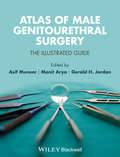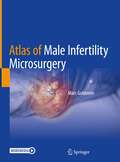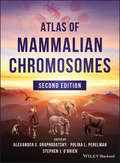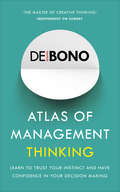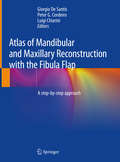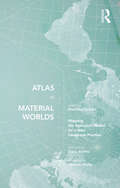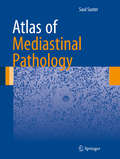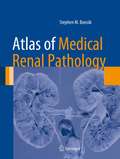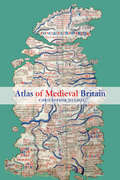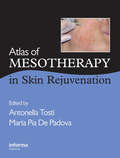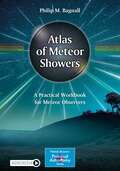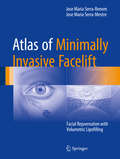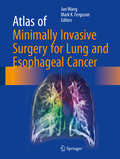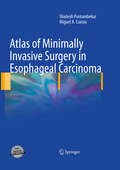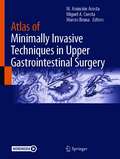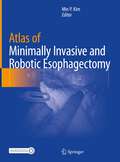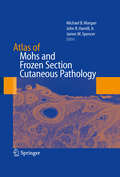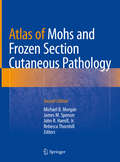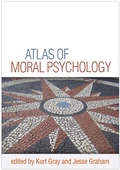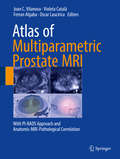- Table View
- List View
Atlas of Male Genital Dermatology
by Anthony HallThis atlas provides a practical guide applicable to the diagnosis and management of skin diseases affecting the male genital area. Chapters feature concise descriptions and advice on potential management strategies and cover sexually transmissible infections, candidal balano-posthitis, rare male genital malignancies, and pigmentary disorders. Every description is accompanied by a broad range of images of a particular disease or disorder, enabling the reader to develop a deeper understanding of both diagnostic and management aspects of skin diseases affecting male genitalia. Atlas of Male Genital Dermatology enables readers to quickly and successfully identify a variety of dermatological disorders that can affect the male genitalia. It provides instruction on how to effectively manage these conditions and is a valuable resource for any physician who encounters these conditions in daily practice.
Atlas of Male Genital Disorders: A Useful Aid for Clinical Diagnosis
by Franco Dinotta Giuseppe Micali Marco Cusini Pompeo DonofrioMale genital disorders represent a common issue in medical practice, especially in the dermatological setting. Correct clinical evaluation of these disorders is essential when addressing the diagnosis, which in some cases may require histopathological confirmation. Depending on the disease, early diagnosis may be not only lifesaving, but also of fundamental importance to the planning of successful treatment. This atlas introduces the most common penile diseases, along with more rarely encountered ones. It provides invaluable guidance on clinical diagnosis by highlighting prominent clinical features and presenting particular videodermatoscopy findings when these are indicative of the diagnosis. In addition, for each condition the most appropriate treatment is proposed, taking into account recent therapeutic advances of proven benefit.
Atlas of Male Genitourethral Surgery
by Manit Arya Asif Muneer Gerald H. JordanMale genitourethral abnormalities are a source of great concern and distress to those affected. Surgery, when required, is very specialized and often extremely complex requiring expert surgical skills in order to achieve the best outcomes. Atlas of Male Genitourethral Surgery: The Illustrated Guideprovides urological surgeons, at all levels of experience from trainees to established specialists, with a full colour, highly illustrated and step-by-step approach to male genitourethral surgery, enabling complete mastery of surgical techniques in this difficult and challenging area. Full-color throughout and with over 430 high-quality images, this comprehensive atlas covers key areas of urologic surgery including:Surgery for penile curvatureUrethral reconstruction and artificial urinary sphinctersPenile and scrotal reconstructionSurgery for male infertilitySurgery for erectile dysfunctionSurgery for penile cancerEach chapter includes an introduction to the condition and its challenge, a step-by step guide to the surgical procedures applicable for that condition with surgical tips and tricks for improved techniques and outcomes. Brought to you by the world's leading experts in the field of genitourethral surgery, this outstanding book guides you through the most challenging of operations, helping you deliver high quality clinical care to your patients.
Atlas of Male Infertility Microsurgery
by Marc GoldsteinInfertility affects approximately 15% of couples attempting to conceive, and male factor is known to be either the primary or a contributing factor in at least half of all cases of couple infertility. More than half of male infertility is amenable to microsurgical treatment, but a majority of urology residency programs provide little or no training in male infertility or its microsurgical treatment. Textbooks typically include a chapter or two on surgery of male infertility, but often these chapters only cover basic concepts and simplified overviews and miss the many finer points that are only taught by observing or scrubbing directly in the operating room. Utilizing Dr. Marc Goldstein's extensive surgical experience, this atlas focuses primarily on microsurgical techniques for restoring and preserving male fertility. The chapters discuss surgical anatomy and diagnosis, microsurgery of the vas deferens and epididymis, varicocele and other fertility-related procedures. Topics and techniques include vasectomy, vasovasostomy, vasoepididymostomy, varicocelectomy, hydrocelectomy, and microsurgically assisted inguinal hernia repair. Equipment, instrumentation and training in microsurgery, including animal models, are also discussed. In each chapter, practical tips and tricks are highlighted. Enhanced by plentiful intraoperative photos and original illustrations, Atlas of Male Infertility Microsurgery is an essential resource for male reproductive surgeons, urologists, residents and fellows.
Atlas of Mammalian Chromosomes
by Alexander S. Graphodatsky Polina L. Perelman Stephen J. O’BrienTHE UPDATED NEW EDITION OF THE POPULAR COLLECTION OF HIGH-RESOLUTION CHROMOSOME PHOTOGRAPHS—FOR GENETICISTS, MAMMOLOGISTS, AND BIOLOGISTS INTERESTED IN COMPARATIVE GENOMICS, SYSTEMATICS, AND CHROMOSOME STRUCTURE Filled with a visually exquisite collection of the banded metaphase chromosome karyotypes from some 1,000 species of mammals, the Atlas of Mammalian Chromosomes offers an unabridged compendium of the state of this genomic art form. The Atlas??contains the best karyotype produced, the common and Latin name of the species, the published citation, and identifies the contributing authors. Nearly all karyotypes are G-banded, revealing the chromosomal bar codes of homologous segments among related species. The Atlas brings together information from a range of cytogenetic literature and features high-quality karyotype images for nearly every mammal studied to date. When the Atlas was first published, only three mammals were sequenced. Today, that number is over 300. Now in its second edition, this book contains extensive revisions and major additions such as new karyotypes that employ G- and C- banding to represent euchromatin and heterochromatin genome composition, new phylogenetic trees for each order, homology segment chromosome information on published aligned chromosome painting. Summaries of the painting data for some species indicate conserved homology segments among compared species. An invaluable resource for today's comparative genomics era, this comprehensive collection of high-resolution chromosome photographs: Assembles information previously scattered throughout the cytogenetics literature in one comprehensive volume Provides chromosome information and illustrations for the karyotypes of 300 new species Addresses the mandate of the Human Genome Project to annotate the genomes of other organisms Serves as a basis for chromosome-level genome assemblies Offers a detailed summation of three decades of ZooFish (chromosome painting) Presents high-resolution photos of karyotypes that represent more than 1,000 mammal species Written for geneticists, mammalogists, and biologists, the Atlas of Mammalian Chromosomes offers a step forward for an understanding of species formation, of genome organization, and of DNA script for natural selection.
Atlas of Management Thinking
by Edward de BonoFirst published in 1981, this was the first book ever to be written explicitly for the right side of the reader’s brain. Much has been made of the research conducted into the left side of the brain – home to language and logic. The right side works in images, whole patterns and undefined feelings – none of which can be verbalized. This more elusive thinking often functions as what is loosely called ‘intuition’. In Atlas, de Bono shows us how to use the right side. It is an atlas because it is a visual reference of images and illustrations that point the reader in the right direction (literally). For anyone who has ever been told to trust their instinct, or who is concerned with management and decision-making, this book is a de Bono classic.
Atlas of Mandibular and Maxillary Reconstruction with the Fibula Flap: A step-by-step approach
by Giorgio De Santis Peter G. Cordeiro Luigi ChiariniThis atlas deals with the standard technique used for reconstructing the mandible and the maxilla - the fibula flap. The reader will find useful information on all issues that are important in the surgical procedure, including the use of CAD-CAM technology (Computer Assisted Technology), bone synthesis and flap modelling. The editors draw on their 30 years of experience to provide a step-by-step description of this surgical procedure. With the help of numerous illustrations, the reader will learn the technical, functional and aesthetic developments since 1989 when this technique was first described.Plastic surgeons, otorhinolaryngologists and oral- and maxillofacial surgeons will find this book a valuable guide to the sophisticated principles of jaw reconstruction and how to apply them in their everyday practice.
Atlas of Material Worlds: Mapping the Agency of Matter for a New Landscape Practice
by Matthew SeibertAtlas of Material Worlds is a highly designed narrative atlas illustrating the agency of nonliving materials with unique, ubiquitous, and often hidden influence on our daily lives. Employing new materialism as a jumping-off point, it examines the increasingly blurry lines between the organic and inorganic, engaging the following questions: What roles do nonliving materials play? Might a closer examination of those roles reveal an undeniable agency we have long overlooked or disregarded? If so, does this material agency change our understanding of the social structures, ecologies, economies, cosmologies, technologies, and landscapes that surround us? And, perhaps most importantly, why does material agency matter? This is the story of the world’s driest nonpolar desert, pink flamingos, and cerulean blue lithium ponds; industrial shipping logistics, pudding-like jiggling substrates, and monuments of mud; galactic bodies, radioactive sheep, and the yellowcake of uranium. Put simply, this book dares readers to see the world anew, from material up. Atlas of Material Worlds offers this new relationship to our host environment in a time of mounting crises—accelerating climate change, ballooning socioeconomic inequality, and rising toxic nationalism—uniquely telling materialist stories for practitioners and students in landscape, architecture, and other built environment disciplines.
Atlas of Mediastinal Pathology (Atlas of Anatomic Pathology)
by Saul SusterThe mediastinum is a virtual compartment in the chest cavity that is the seat of several vital organs and structures that can be involved in a variety of pathologic processes, including congenital and developmental abnormalities, inflammatory conditions, and benign and malignant neoplasms. The Atlas of Mediastinal Pathology provides a pictorial survey of the major disease processes that can affect this anatomic compartment, including congenital and acquired cysts, benign hamartomatous processes, inflammatory processes involving the mediastinum, and benign and malignant neoplasms. The latter includes tumors of the thymus (thymoma and thymic carcinoma), neuroendocrine neoplasms, germ cell tumors, mesenchymal neoplasms, and hematolymphoid malignancies. The use of ancillary diagnostic methods is illustrated, where appropriate, providing assistance for pathologists in arriving at the correct diagnosis.
Atlas of Medical Renal Pathology (Atlas of Anatomic Pathology)
by Stephen M. BonsibThe kidney is an organ with complex organogenesis susceptible to numerous misadventures in development and is exposed to a diverse array of insults of hematogenous and lower urinary tract origin. This Atlas of Medical Renal Pathology provides an overview of the development, macroscopic and microscopic features of the normal kidney. This is followed by a comprehensive survey of developmental and cystic kidney diseases, vascular diseases and tubulointerstitial diseases. An emphasis is placed on gross diagnostic findings with detailed histological correlates. In addition, the histological, immunofluorescent, immunohistochemical and ultrastructural features of the major glomerular diseases and renal transplantation pathology are presented. This compendium of non-neoplastic kidney diseases illustrates the vast majority diseases you are likely to encounter in surgical and autopsy pathology.
Atlas of Medieval Britain
by Christopher DaniellChristopher Daniell's Atlas of Medieval Britain presents a sweeping visual survey of Britain from the Roman occupation to 1485. Annotated throughout with clear commentary, this volume tells the story of the British Isles, and makes visually accessible the varied and often complex world of the Middle Ages. The Atlas depicts the spatial distribution of key events and buildings between 1066 and 1485, as well as providing the relevant Anglo-Saxon background. Charting the main political, administrative and religious features of medieval society, the maps also locate cultural landmarks such as the sites of mystery plays, universities and specific architectural styles. Topics covered include: Iron Age and Roman occupation Anglo-Saxons and Vikings changing political scenarios within England, Scotland, Wales and Ireland religious framework, including diocesan boundaries, monasteries and friaries government, society and economy. Complete with recommended further reading, this volume is an indispensable reference resource for all students of medieval British history.
Atlas of Mesotherapy in Skin Rejuvenation
by Antonella Tosti Maria Pia De PadovaThe injection of a combination of vitamins and medications into the middle layer of the skin has been practised in continental Europe for some fifty years now, but because the literature has hitherto not been published in English the topic is still surrounded by a great deal of ignorance and prejudice. This atlas from a renowned authorship will doc
Atlas of Meteor Showers: A Practical Workbook for Meteor Observers (The Patrick Moore Practical Astronomy Series)
by Philip M. BagnallThis atlas contains everything you need to know about meteor showers and how to observe them. It begins with the science behind these celestial fireworks, then equips you with all the practical knowledge you’ll need to make the most of these wonderful astronomical events. The book is rich with illustrations, graphs and resources to assist your hobby. In addition, it includes downloadable radiant charts, report sheets, radiant altitude data, plotting charts and more, to help you locate each shower, record its activity and plot individual meteors during your nights of observation. Intended for amateurs of all levels and requiring no special equipment, this accessible Atlas of Meteor Showers will hone your skills and keep you engaged throughout the year, no matter where you are in the world.
Atlas of Meteorites
by Monica M. Grady Giovanni Pratesi Vanni Moggi Cecchi Monica M. Grady Giovanni PratesiA complete visual reference for meteorite classification, this atlas combines high resolution optical microscope images with detailed descriptions. It provides a systematic account of meteorites and their most important classification parameters, making it an essential resource for meteorite researchers. Each chapter starts with a description of the meteorite class, with a summary of the mineralogical, chemical and isotopic characteristics of the group. The full-color images are taken in plane- and cross-polarized light and reflected light, and arranged to highlight textural variations in meteorites. Specimens are grouped to show the effects of increasing thermal alteration and shock, as well as variations in chondrule size and type. Chapters on iron meteorites, pallasites and mesosiderites are included, photographed as mounts in reflected light, to show the range of textural variations that accompany these meteorites. Images from the book can be downloaded from www. cambridge. org/9780521840354.
Atlas of Mineral Deposits Distribution in China (The China Geological Survey Series)
by Fanyu Qi Xiaolei Li Yuntao Shang Jie Meng Xuezheng Gao Zhaoyu Kong Haixin Li Haifei YanThis open access book includes instruction of national mineral database 2020 and atlas of national mineral deposits distribution derived from national mineral database 2020. National mineral database 2020 is based on data from National Geological Archives China(NGAC).Moreover, it introduces the construction method and updates maintenance mechanism of the mineral deposits database and proposes the concept of updating data based on collected archives. The construction guideline on national mineral deposits database provides guiding framework for the future development on geological database.
Atlas of Minimally Invasive Facelift: Facial Rejuvenation with Volumetric Lipofilling
by Jose Maria Serra-Renom Jose Maria Serra-MestreThis atlas provides a concise overview of the principle of fat grafting and its clinical applications to treat aging in the central areas of the face in a minimally invasive manner. The authors start with a short description of the anatomical basis of facial aging and by presenting current facial rejuvenation techniques. Here the emphasis is on the process of harvesting and preparing macro-, micro-, intradermal and nano-fat for injection. Thanks to the book's numerous illustrations and short descriptions, readers will find valuable information on where and how to inject the fat combined with the authors' individual techniques and refinements. Aging is a major issue in today's society. Facial rejuvenation procedures seek to enhance the final outcome and durability of surgery and to minimize drawbacks. The current trend is to use less invasive methods requiring fewer incisions, which produce more natural-looking results. This atlas shows the authors' personal techniques to help achieve that goal.
Atlas of Minimally Invasive Hand and Wrist Surgery (Minimally Invasive Procedures in Orthopaedic Surgery)
by John T. Capo Virak TanHand and wrist surgery is evolving rapidly and often, advances are directed at developing procedures that are less invasive, with smaller incisions and shorter rehabilitation times. Minimally Invasive Hand and Wrist Surgery is the only book devoted exclusively to these exciting new percutaneous and minimal access techniques for the treatment of chr
Atlas of Minimally Invasive Surgery for Lung and Esophageal Cancer
by Mark K. Ferguson Jun WangThis Atlas presents a state-of-the-art review of VATS and robotic approaches to managing lung and esophageal cancers. It discusses cancer staging, physiological evaluation of patients, and patient selection for minimally invasive surgery and offers detailed descriptions of individual operations accompanied by anatomic drawings, intraoperative images, and 3-dimensional anatomic reconstructions. Written by recognized experts in the field, it provides readers with an unparalleled resource for advancing their skills in managing these cancers. It is a valuable reference work for thoracic surgeons in training as well as in practice who want to pursue minimally invasive surgery. It is unique in offering fully illustrated, step-by-step descriptions of the operative procedures.
Atlas of Minimally Invasive Surgery in Esophageal Carcinoma
by Miguel Cuesta Shailesh PuntambekarThe main aim of this book is standardization of the procedure with stress on simplification and ease of performing the surgery. In oncology, the principles and steps of an operative procedure should remain the same; though the modality may change, be it either open surgery or laparoscopy. Thus, in this book the patient position and procedural steps are devised to mimic open surgery as far as possible. This makes it easier for the oesophageal surgeon performing surgeries by the open technique to get converted into a thoracoscopic laparoscopic surgeon. This atlas will be a step by step guide for a surgeon who wishes to perform laparoscopy with more than 500 operative photographs.
Atlas of Minimally Invasive Techniques in Upper Gastrointestinal Surgery
by Miguel A. Cuesta M. Asunción Acosta Marcos BrunaThis Atlas comprehensively covers minimally invasive operative techniques for benign and malignant cancer surgery of the esophagus and stomach. It provides easy-to-follow instructions accompanied by a range of pictures and illustrations, as well as a collection of interactive videos to aid the reader in developing a deeper understanding of each surgical procedure. Techniques covered include minimally invasive surgical treatment for esophageal and gastric cancer including different approaches such as thoracoscopic, transhiatal, laparoscopic, and robot-assisted resections. These chapters include different types of cervical and intrathoracic anastomoses after esophageal resections, and different anastomoses and reconstructions after gastrectomy. Moreover, the Atlas includes an extensive description of minimally invasive procedures in bariatric surgery including sleeve resection, gastric bypass, biliopancreatic diversion, and others. Minimally invasive approaches for other benign pathologies such as benign tumors and treatment of gastroduodenal ulcer complications are also depicted. All chapters, written by a renowned and experienced international group of surgeons and their teams, are focused on practical step-by-step description of the techniques. Atlas of Minimally Invasive Techniques in Upper Gastrointestinal Surgery systematically describes the most frequently performed surgical procedures of the esophagus and stomach and is a valuable resource for all practicing surgeons and trainee general surgeons dedicated to upper gastrointestinal surgery, such as bariatric and surgical oncologists.
Atlas of Minimally Invasive and Robotic Esophagectomy
by Min P. KimThe book demonstrates the step-by-step method of performing minimally invasive esophagectomy and robot-assisted esophagectomy. Chapters cover the techniques of performing minimally invasive and robot-assisted Ivor Lewis esophagectomy and McKeown esophagectomy as well as variation in methods of chest and neck anastomosis and a method to perform jejunostomy tube placement. Each author provides a narrative on their technique in performing the esophagectomy with pearls for different parts of the operation. As with any other surgical procedure, there are controversies about how to handle different parts of the operation. The goal of the book is not to debate the best method, but to provide a method to perform the complex operation in a minimally invasive way. Atlas of Minimally Invasive and Robotic Esophagectomy incorporates robot-assisted esophagectomy techniques and aims to benefit specialists and trainees that treat patients with esophageal cancer.
Atlas of Mohs and Frozen Section Cutaneous Pathology
by John R. Hamill James M. Spencer Michael MorganOf all the techniques used to treat non melanoma skin cancer, the highest cure rates belong to the Mohs surgical procedure. Critical to this technique is optimal preparation and interpretation of frozen sections. With more than 400 high resolution figures, the Atlas of Mohs and Frozen Section Cutaneous Pathology is the premier textbook on the topic, serving as a highly practical guide to microscopic analysis, diagnosis, and discrimination of common and problematic cutaneous neoplasms. Highlights of the Atlas include diagnosis of basic and routine dermatologic entities, diagnosis and distinction of rare and/or deadly neoplasms such as dermatofibrosarcoma protuberans and merkel cell carcinoma, a troubleshooting guide dealing with quality control of the frozen section technique, and discussion of new techniques including immunohistochemistry. Comprehensive and presented in full color, the Atlas of Mohs and Frozen Section Cutaneous Pathology is an indispensable reference for anyone involved with the Mohs procedure, including dermatologic surgeons, Mohs cutaneous surgeons, as well as pathologists and dermatopathologists who perform frozen section analysis of cutaneous specimens.
Atlas of Mohs and Frozen Section Cutaneous Pathology
by James M. Spencer Michael B. Morgan John R. Hamill Jr. Rebecca ThornhillOf all the techniques used to treat non melanoma skin cancer, the highest cure rates belong to the Mohs surgical procedure. Critical to this technique is optimal preparation and interpretation of frozen sections. The second edition of this highly successful atlas details both common and uncommon cutaneous neoplasms that can serve as a source of reference for established practitioners and a review for those in training. It includes new frozen section specimens, the most current diagnostic guidelines, and discussion of the advancements in tissue staining. There is also an additional chapter with self-study tools, where readers can test their knowledge using various images with a multiple choice answer format, followed by a discussion of the correct answer. With high resolution figures, the Atlas of Mohs and Frozen Section Cutaneous Pathology, Second Edition is the premier text on the topic, serving as a highly practical guide to microscopic analysis, diagnosis, and discrimination of common and problematic cutaneous neoplasms. Highlights of the Atlas include diagnosis of basic and routine dermatologic entities, diagnosis and distinction of rare and/or deadly neoplasms such as dermatofibrosarcoma protuberans and merkel cell carcinoma, a troubleshooting guide dealing with quality control of the frozen section technique, and discussion of techniques including immunohistochemistry. Comprehensive and presented in full color, the Atlas of Mohs and Frozen Section Cutaneous Pathology, Second Edition is an indispensable reference for anyone involved with the Mohs procedure, including dermatologic surgeons, Mohs cutaneous surgeons, as well as pathologists and dermatopathologists who perform frozen section analysis of cutaneous specimens.
Atlas of Moral Psychology
by Kurt Gray Jesse GrahamThis comprehensive and cutting-edge volume maps out the terrain of moral psychology, a dynamic and evolving area of research. In 57 concise chapters, leading authorities and up-and-coming scholars explore fundamental issues and current controversies. The volume systematically reviews the empirical evidence base and presents influential theories of moral judgment and behavior. It is organized around the key questions that must be addressed for a complete understanding of the moral mind.
Atlas of Multiparametric Prostate MRI: With PI-RADS Approach and Anatomic-MRI-Pathological Correlation
by Joan C. Vilanova Violeta Catalá Ferran Algaba Oscar LauciricaThis atlas provides a comprehensive, state of the art review of the use of multiparametric MRI (mpMRI) for the imaging of prostate cancer, covering aspects from diagnosis and loco-regional staging through to the role of the technique after treatment and follow-up. The book contains a wealth of high-resolution images, many of them in color, and displays the anatomical-MRI-pathological correlation whenever appropriate. Readers will find a helpful overview on the current standardized method for reading and reporting on mpMRI, the Prostate Imaging Reporting and Data System (PI-RADS), version 2. Dedicated chapters focus on differential diagnosis and imaging pitfalls, and the inclusion of helpful diagrams and algorithms will further assist in image interpretation, enabling readers to ease and improve their use of mpMRI. Edited and written by very experienced radiologists, pathologists, and urologists; the Atlas of Multiparametric Prostate MRI will serve as a unique source of clinically relevant information and an aid to disease management for radiologists, urologists, pathologists, radiotherapists, and oncologists.
